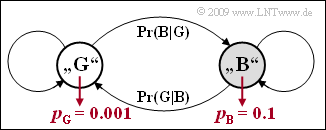Exercise 5.6Z: Gilbert-Elliott Model
We consider the burst error channel model according to "E.N. Gilbert" and E.O. Elliott (see sketch). For the transition probabilities let hold:
- $${\rm Pr}(\rm G\hspace{0.05cm}|\hspace{0.05cm} B)= 0.1, \hspace{0.2cm} {\rm Pr}(\rm B\hspace{0.05cm}|\hspace{0.05cm} G) = 0.01\hspace{0.05cm}.$$
The error probability in the state "GOOD" is $p_{\rm G} = 0.1\%$. For the state "BAD" is $p_{\rm B} = 10\%$.
In the course of this exercise, further parameters are to be determined:
- the average error probability $p_{\rm M}$,
- the state probabilities $w_{\rm G} = \rm Pr(Z = G)$ and $w_{\rm B} = \rm Pr(Z = B)$,
- the values of the correlation function, which for $k > 0$ is given analytically as follows:
- $$\varphi_{e}(k) = p_{\rm M}^2 + (p_{\rm B} - p_{\rm M}) \cdot (p_{\rm M} - p_{\rm G}) \cdot \big [1 - {\rm Pr}(\rm B\hspace{0.05cm}|\hspace{0.05cm} G )- {\rm Pr}(\rm G\hspace{0.05cm}|\hspace{0.05cm} B )\big ]^{\it k} \hspace{0.05cm}.$$
Notes:
- The exercise belongs to the chapter "Burst Error Channels".
- However, reference is also made to the chapter "Markov chains" in the book "Theory of Stochastic Signals" and in particular to the section "Error correlation function of the Gilbert-Elliott model" in the book "Channel Coding".
Questions
Solution
(2) The GE model is a stationary Markov chain.
- For the probability that it is in the state "GOOD", taking into account the result of subtask (1):
- $$w_{\rm G} = {\rm Pr}(\rm G\hspace{0.05cm}|\hspace{0.05cm} G) \cdot w_{\rm G} + {\rm Pr}(\rm G\hspace{0.05cm}|\hspace{0.05cm} B) \cdot w_{\rm B}\hspace{0.3cm} \Rightarrow \hspace{0.3cm} {\rm Pr}(\rm B\hspace{0.05cm}|\hspace{0.05cm} G) \cdot w_{\rm G} = {\rm Pr}(\rm G\hspace{0.05cm}|\hspace{0.05cm} B) \cdot w_{\rm B} \hspace{0.05cm}.$$
- Further, $w_{\rm B} = 1 \, –w_{\rm G}$:
- $${\rm Pr}(\rm B\hspace{0.05cm}|\hspace{0.05cm} G) \cdot w_{\rm G} + {\rm Pr}(\rm G\hspace{0.05cm}|\hspace{0.05cm} B) \cdot w_{\rm G} = {\rm Pr}(\rm G\hspace{0.05cm}|\hspace{0.05cm} B)$$
- $$\Rightarrow \hspace{0.3cm} w_{\rm G} = \frac{{\rm Pr}(\rm G\hspace{0.05cm}|\hspace{0.05cm} B)}{{\rm Pr}(\rm G\hspace{0.05cm}|\hspace{0.05cm} B) + {\rm Pr}(\rm B\hspace{0.05cm}|\hspace{0.05cm} G)} = \frac{0.1}{0.1 + 0.01} \hspace{0.15cm}\underline {\approx 0.909} \hspace{0.05cm},\hspace{0.2cm} w_{\rm B} = 1 - w_{\rm G }\hspace{0.15cm}\underline {\approx 0.091}\hspace{0.05cm}.$$
(3) The mean error probability $p_{\rm M}$ is obtained from the error probabilities $p_{\rm G}$ and $p_{\rm B}$ weighted by $w_{\rm G}$ and $w_{\rm B}$:
- $$p_{\rm M} = w_{\rm G} \cdot p_{\rm G} + w_{\rm B} \cdot p_{\rm B} = \frac{10}{11} \cdot 10^{-3} + \frac{1}{11} \cdot 10^{-1}= \frac{10+100}{11} \cdot 10^{-3}\hspace{0.15cm}\underline { = 1\%}\hspace{0.05cm}.$$
(4) According to the general equation on the specification section, for $k > 0$:
- $$\varphi_{e}(k) \hspace{-0.1cm} \ = \ \hspace{-0.1cm} p_{\rm M}^2 + (p_{\rm B} - p_{\rm M}) \cdot (p_{\rm M} - p_{\rm G}) \cdot [1 - {\rm Pr}(\rm B\hspace{0.05cm}|\hspace{0.05cm} G )- {\rm Pr}(\rm G\hspace{0.05cm}|\hspace{0.05cm} B )]^{\it k} = 10^{-4} + 0.09 \cdot 0.009 \cdot 0.89^{\it k} = 10^{-4} \cdot \left ( 1 + 8.1 \cdot 0.89^{\it k} \right )\hspace{0.05cm}.$$
- $$\Rightarrow \hspace{0.3cm}\varphi_{e}(k = 1 ) \hspace{-0.1cm} \ = \ \hspace{-0.1cm} 10^{-4} \cdot \left ( 1 + 8.1 \cdot 0.89^{ 1} \right ) \hspace{0.15cm}\underline {= 8.209 \cdot 10^{-4}} \hspace{0.05cm},$$
- $$\Rightarrow \hspace{0.3cm}\varphi_{e}(k = 2 ) \hspace{-0.1cm} \ = \ \hspace{-0.1cm} 10^{-4} \cdot \left ( 1 + 8.1 \cdot 0.89^{ 2} \right )\hspace{0.15cm}\underline { = 7.416 \cdot 10^{-4}} \hspace{0.05cm},$$
- $$\Rightarrow \hspace{0.3cm}\varphi_{e}(k = 5 ) \hspace{-0.1cm} \ = \ \hspace{-0.1cm} 10^{-4} \cdot \left ( 1 + 8.1 \cdot 0.89^{ 5} \right )\hspace{0.15cm}\underline {= 5.523 \cdot 10^{-4}} \hspace{0.05cm},$$
- $$\Rightarrow \hspace{0.3cm}\varphi_{e}(k = 50 ) \hspace{-0.1cm} \ = \ \hspace{-0.1cm} 10^{-4} \cdot \left ( 1 + 8.1 \cdot 0.89^{ 50} \right ) \hspace{0.15cm}\underline {= 1.024 \cdot 10^{-4}} \hspace{0.05cm}.$$
(5) For each channel model, because of $e_{\nu} ∈ \{0, 1\}$:
- $$\varphi_{e}(k = 0 ) = {\rm E}[e_{\nu} ^2] = {\rm E}[e_{\nu} ] = p_{\rm M} \hspace{0.05cm}.$$
Using the result of subtask (3), $\varphi_e(k = 0) \ \underline {= 0.01}$ for the present case.
(6) According to subtask (3) holds:
- $$p_{\rm M} = {10}/{11} \cdot p_{\rm G} + {1}/{11} \cdot p_{\rm B} \hspace{0.05cm}.$$
- With given $p_{\rm B} = 0.1$, even for $p_{\rm G} = 0$ (no error in state "G"), the average error probability is $p_{\rm M} \approx 0.009$.
- In contrast, with fixed $p_{\rm G} = 0.001$ the value $p_{\rm M} = 0.005$ is achievable:
- $$0.005 = {10}/{11} \cdot 10^{-3} + {1}/{11} \cdot p_{\rm B} \hspace{0.3cm} \Rightarrow \hspace{0.3cm} p_{\rm B} \le 0.055 - 0.1 = 4.5\%\hspace{0.05cm}.$$
- Furthermore, the mean error probability (with given $p_{\rm G}$ and $p_{\rm B}$) can also be represented as follows:
- $$p_{\rm M} = \frac{p_{\rm G} \cdot {\rm Pr}(\rm G\hspace{0.05cm}|\hspace{0.05cm} B)+ p_{\rm B} \cdot {\rm Pr}(\rm B\hspace{0.05cm}|\hspace{0.05cm} G)}{{\rm Pr}(\rm G\hspace{0.05cm}|\hspace{0.05cm} B) + {\rm Pr}(\rm B\hspace{0.05cm}|\hspace{0.05cm} G)} = \frac{0.001 \cdot {\rm Pr}(\rm G\hspace{0.05cm}|\hspace{0.05cm} B)+ 0.1 \cdot {\rm Pr}(\rm B\hspace{0.05cm}|\hspace{0.05cm} G)}{{\rm Pr}(\rm G\hspace{0.05cm}|\hspace{0.05cm} B) + {\rm Pr}(\rm B\hspace{0.05cm}|\hspace{0.05cm} G)}\hspace{0.05cm}.$$
- With $\rm Pr(B|G) = 0.01$ and with $\rm Pr(G|B) = 0.1$, respectively, the following equations are obtained:
- $${\rm Pr}(\rm B\hspace{0.05cm}|\hspace{0.05cm} G) = 0.01\hspace{-0.15cm}:\hspace{0.2cm} {\it p}_{\rm M} \hspace{-0.1cm} \ = \ \hspace{-0.1cm} \frac{0.001 \cdot {\rm Pr}(\rm G\hspace{0.05cm}|\hspace{0.05cm} B)+ 0.001 }{{\rm Pr}(\rm G\hspace{0.05cm}|\hspace{0.05cm} B) + 0.01}\hspace{0.05cm},\hspace{0.5cm} {\rm Pr}(\rm G\hspace{0.05cm}|\hspace{0.05cm} B) = 0.1\hspace{-0.15cm}:\hspace{0.2cm}{\it p}_{\rm M} \hspace{-0.1cm} \ = \ \hspace{-0.1cm} \frac{0.0001 + 0.1 \cdot {\rm Pr}(\rm B\hspace{0.05cm}|\hspace{0.05cm} G)}{0.1 +{\rm Pr}(\rm G\hspace{0.05cm}|\hspace{0.05cm} B) }\hspace{0.05cm}.$$
- From the last equation it can be seen that with no $\rm Pr(G|B)$ value the result $p_{\rm M} = 0.005$ is possible.
- On the other hand, with a smaller $\rm Pr(B|G)$ the condition can be fulfilled:
- $$0.005 = \frac{0.0001 + 0.1 \cdot {\rm Pr}(\rm B\hspace{0.05cm}|\hspace{0.05cm} G)}{0.1 +{\rm Pr}(\rm B\hspace{0.05cm}|\hspace{0.05cm} G) } \hspace{0.3cm} \Rightarrow \hspace{0.3cm}{\rm Pr}(\rm B\hspace{0.05cm}|\hspace{0.05cm} G) \le \frac{0.0004}{0.095} \approx 0.0042\hspace{0.05cm}.$$
- Solutions 2 and 4 are therefore correct.
